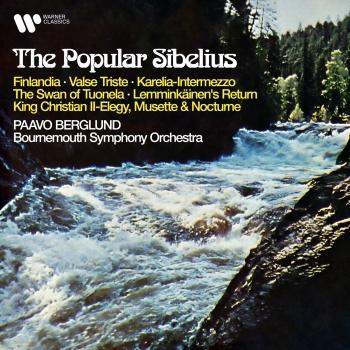Bournemouth Symphony Orchestra & Paavo Berglund
Biography Bournemouth Symphony Orchestra & Paavo Berglund
Paavo Berglund
was born in the capital of Finland, Helsinki. When he was eleven years of age he began to learn the violin, using an instrument made by his grandfather; formal study took place in Helsinki at the Sibelius Academy, in Vienna and in Salzburg. At the age of twenty, in 1949, he joined the Finnish Radio Symphony Orchestra as a violinist. In 1952, together with several other players, he helped to form the Helsinki Chamber Orchestra, becoming its first conductor; the orchestra’s aim was to expand the repertoire of orchestral music to be heard in Helsinki. Henceforth Berglund’s career as a conductor developed at a steady pace in his home country. In 1956 he was appointed assistant conductor of the Finnish Radio Symphony Orchestra, becoming the orchestra’s chief conductor in 1962 and retaining this position until 1971. Through rigorous and extensive rehearsals, he greatly improved its performing standards and gained a reputation as a strict orchestral disciplinarian. In 1967 he led the orchestra on its first tour of England.
During the 1960s Berglund started to appear abroad, throughout Europe, and in Japan and Australia. He made his début with the Bournemouth Symphony Orchestra in 1965, conducting in a series of concerts to mark the centenary of the birth of Sibelius. He established a good relationship with the orchestra, whose chief conductor at this time was Constantin Silvestri, and was invited to return regularly. In 1970 he led the orchestra in a rare performance of Sibelius’s long-suppressed Kullervo Symphony. This aroused great interest and with these artists EMI made the first-ever recording of this work. Following Silvestri’s death in 1969, Berglund was invited to become the chief conductor of the Bournemouth Symphony Orchestra. He left the Finnish Radio Symphony Orchestra in 1971 and led the Bournemouth Orchestra with distinction between 1972 and 1979, significantly raising its performing standards, as can be heard from the many recordings made by it for EMI during this period.
In 1975 Berglund returned to Finland to take up the post of chief conductor of the Helsinki Philharmonic Orchestra. Now very busy internationally, he made his début in the USA with the American Symphony Orchestra in New York in 1978. The success of this led to invitations to conduct throughout North America, and he appeared with leading orchestras in New York, Cleveland, Washington, Pittsburgh, San Francisco and Toronto. In 1979 he resigned from his posts in both Bournemouth and Helsinki. His next permanent positions were as principal guest conductor of the Scottish National Orchestra, from 1981 to 1985; chief conductor of the Stockholm Philharmonic Orchestra from 1987 to 1991; and chief conductor of the Royal Danish Orchestra, from 1993 to 1998. During this period it was observed, especially in Finland, that Berglund had mellowed as an orchestra trainer. He himself has noted the extraordinary rise in the standards of orchestral playing in Finland, commenting in 1996, “The rise in the standard of Finnish orchestras has been quite incredible. Young musicians play so much better than their predecessors did. Without being aware of it myself, I have become part of the old generation and must seem to young musicians like an apparition from the past.”
In 1998 Berglund conducted the Chamber Orchestra of Europe at the Edinburgh Festival in a complete cycle of the Sibelius symphonies, which was notable for using smaller string forces than usual in some of the symphonies. The result was highly praised, and was committed to record on the Finlandia label. This was his third recorded cycle of the Sibelius symphonies, the other two having both been recorded for EMI, firstly with the Bournemouth Symphony Orchestra, and secondly with the Helsinki Philharmonic Orchestra. Guest engagements have seen Berglund conducting all the major European orchestras, such as the Berlin Philharmonic, the London Symphony, the Dresden Staatskapelle, the St Petersburg and Moscow Philharmonics, the Leipzig Gewandhaus and the Israel Philharmonic Orchestras.
Berglund had a commanding presence upon the rostrum and unusually was a left-handed conductor. He was meticulous in rehearsal, with an especially fine ear for orchestral balance, not surprising given that one of his conducting heroes was Arturo Toscanini. At the same time he was an admirer of the interpretative genius of Wilhelm Furtwängler, noting that there was often a dynamic conflict between accuracy and atmosphere. “The early Sibelius conductor Georg Schnéevoigt once complained that he couldn’t get the details out of Sibelius”s scores. Sibelius said that he should simply swim in the gravy!’ Berglund’s performances, like those of his two mentors, had a powerful sense of inevitability about them.
His discography is extensive. As well as the three Sibelius symphony cycles, he recorded an impressive set of the symphonies of Carl Nielsen with the Royal Danish Orchestra for RCA. His readings of the symphonies of Shostakovich were extremely powerful: for EMI he recorded several of the most demanding, notably Nos 5, 6, 7 and 11, with the Bournemouth Symphony Orchestra. Also of note were idiomatic recordings of Vaughan Williams’s Symphony No 4 with the Royal Philharmonic Orchestra, and of Smetana’s My Country with the Dresden Staatskapelle. Berglund was a keen proponent of Finnish composers and recorded the music of fellow countrymen Joonas Kokkonen and Einar Englund. Underneath Berglund’s craggy musical exterior there was a strong emotional core. As he himself said, ‘I conduct from the heart.’










